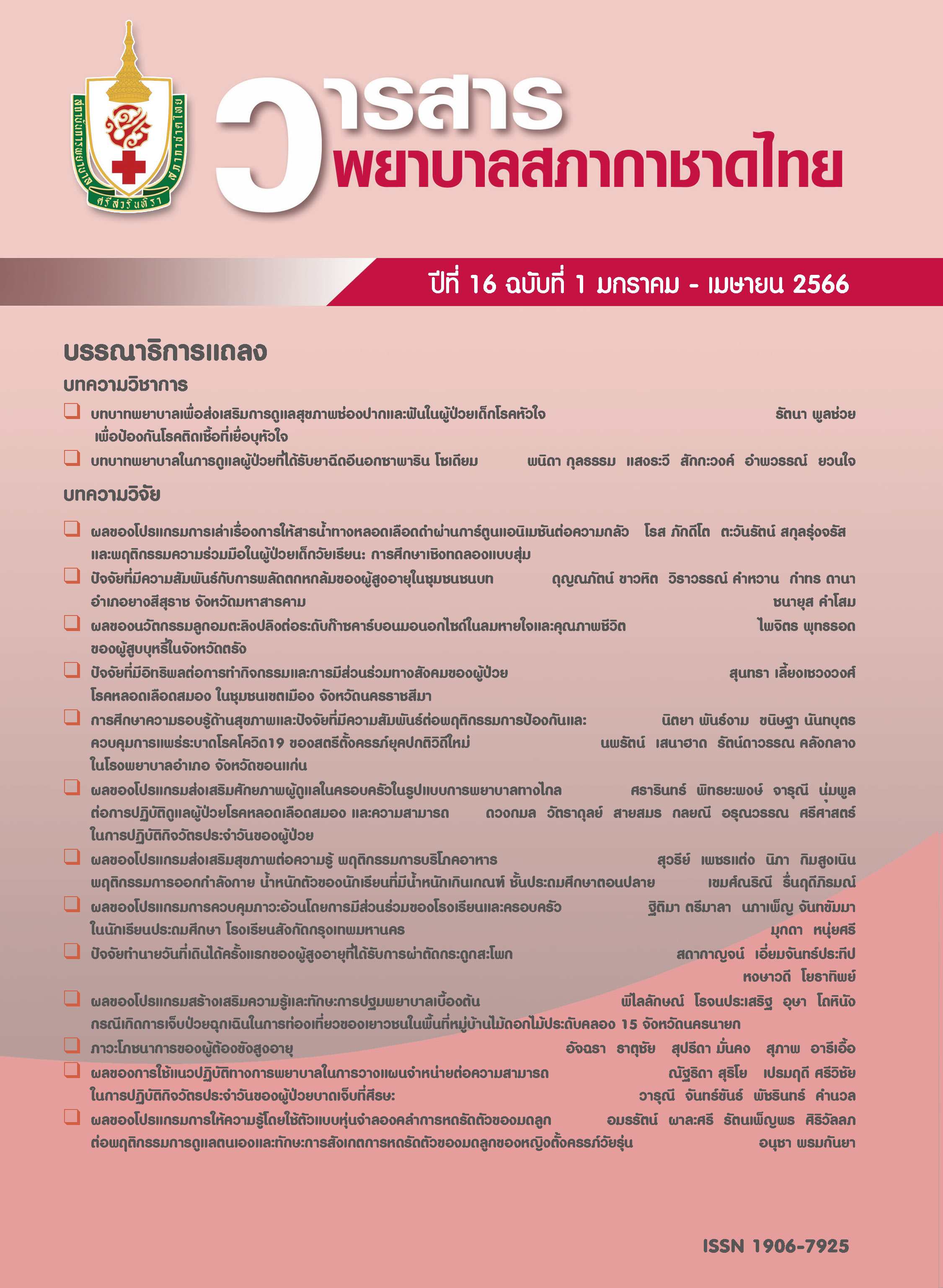Effects of a Cartoon Animation as an Intravenous Therapy Program on Fear Perception and Cooperation Behavior in School - Age Children: A Randomized Controlled Trial Study
Keywords:
cartoon animation, intravenous therapy, fear, cooperation behavior, school-age childrenAbstract
This research aimed to study the effectiveness of a cartoon animation as an intravenous therapy program on the levels of fear perception and cooperation in school-age children. This program is based on the self-regulation theory of Leventhal & Johnson, 1983. The participants were 66 children who attended the pediatric outpatient department in a university hospital. They were divided into three groups: 22 each in the experimental group and two control groups. The research instrument was the cartoon animation used as an intravenous therapy program, and the data collection instruments included a personal information questionnaire, self - reported measures of fear, and a cooperation behavior observation scale. All data were analyzed using descriptive statistics, t - test, and one - way ANOVA. The results revealed that the mean score of fear after intervention was significantly lower than before intervention (p = .028). There was no significant difference in fear and cooperation between the intervention group and the control group (p > .05). Thus, using cartoon animation as an intravenous therapy program decreased the fear of intravenous procedure in school-age children.
References
Supsung A, Khunkaew S, Udomlerd M. Managing fear needle pain in children: nursing practice in pediatric care. J Royal Thai Army Nurses 2017;18(Suppl):25-31. (in Thai)
Aungkaprasatchai W, Pongjaturawit Y. The fear of surgical treatments in school-aged children. J Prapokklao Hosp Clin Med Educat Center 2018;35(2):222-30. (in Thai)
Kasonbua P, Nabkasorn C, Hengudomsub P. Effect of humor media program on fear of school-age children receiving intravenous infusion. The Journal of Faculty of Nursing Burapha University 2016;24(2):61-71.
Khuttamasoon T, Jirapeat V, Ua-Kit N. The effect of pediatric patient preparation combined with computer-assisted instruction program on compliance behavior in peripheral intravenous infusion among school-age children. J Royal Thai Army Nurses 2015;16(1):70-7. (in Thai)
Chaichanasang T, Siripul P. Effects of using a distraction technique on pain from intravenous cannulation in school-age children. Journal of Nursing Science & Health 2010;33(4):78-86. (in Thai)
Premsrirat U. Storytelling in communication work: a study from research. Journal of Communication and Innovation NIDA 2015;2(1):31-58. (in Thai)
Thongmee S, Sanguanwongwan S, Sricharoen S. Development of clinical nursing practice guideline for reducing preoperative anxiety and increasing cooperation in children during induction of general anesthesia at Sunpasitthiprasong hospital Ubon Ratchathani. J Health Sci BCNSP 2020;4(1):77-100. (in Thai)
Prasertsung S. The Effect of pediatric patient preparation in school-age children receiving intravenous infusion [Dissertation]. Chiang Mai: Chiang Mai University; 1999. (in Thai)
Leventhal H, Johnson JE. Laboratory and field experimentation: development of a theory of self-regulation. In: Wooldridge PJ, Schmitt MH, Skipper JK, Leonard RC, editors. Behavioral science and nursing theory. St. Louis: C.V. Mosby; 1983. p. 189-262.
Todorov T, Weinstein A. Structural analysis of narrative. NOVEL: A Forum on Fiction 1969;3(1):70-6.
Thampanichawat W. Self-regulation theory: concepts and application in care of children and families. Thai Journal of Nursing Council 2010;25(4):23-3. (in Thai)
Pavarojkit P, Chandarasiri P, Buathong N. Therapeutic play for children coping with stress underwent venipuncture at King Chulalongkoren Memorial hospital. Chula Med Bull 2019;1(4): 323-35. (in Thai)
Lamchang S, Suklerttrakul T, Lamchang P, Junpunyaskool O, Sirisub P. Effects of information provision via computer multimedia on knowledge and fear of hospitalization among school-age children with acute illness. Journal of Public Health 2013;43(2):150-63.
Hsieh YC, Cheng SF, Tsay PK, Su WJ, Cho YH, Chen CW. Effectiveness of cognitive-behavioral program on pain and fear in school-aged children undergoing intravenous placement. Asian Nurs Res 2017;11(4):261-7.
Düzkaya DS, Bozkurt G, Ulupınar S, Uysal G, Uçar S, Uysalol M. The Effect of a cartoon and an information video about intravenous insertion on pain and fear in children aged 6 to 12 years in the pediatric emergency unit: a randomized controlled trial. Journal of Emergency Nursing 2021;47(1):76–87.
Murad MH, Ingle NA, Assery MK. Evaluating factors associated with fear and anxiety to dental treatment-a systematic review. J Family Med Prim Care 2020;9(9):4530-5.
Kerdmongkhol K, Chaiyawat W. The effect of giving concrete objective information with maternal participation on fear of intravenous infusion among preschooler. Journal of Nursing Science Chulalongkorn University 2016;28(2):25-34. (in Thai)
Ruksrithong T, Chaiyawat W. The effect of nursing care to relieve pain and parental participative nursing care on fear among preschoolers receiving intravenous fluid infusion. Journal of Nursing Science Chulalongkorn University 2016;28(1):67-78. (in Thai)
Khamenkan K. Intravenous cannulation procedure in pediatric patients: nursing strategies to success. Journal of Nursing Science & Health 2012;35(2):131-9. (in Thai)
Subprasert K, Chaiyawat W, Rojnawee S. The effect of nursing program focusing pain reduction on fear of intravenous catheterization among preschoolers. Journal of Nursing Science Chulalongkorn University 2021;33(3):43-57. (in Thai)
Roonmai J, Mongkonsin D, Kerdmongkhol K. Effect of distraction technique and environmental design on fear of intravenous fluid administration in preschool aged children. Thai Journal of Nursing and Midwifery Practice 2018;5(2):55-68. (in Thai)
Downloads
Published
Issue
Section
License
Copyright (c) 2023 Srisavarindhira Thai Red Cross Institute of Nursing

This work is licensed under a Creative Commons Attribution-NonCommercial-NoDerivatives 4.0 International License.
เนื้อหาบทความหรือข้อคิดเห็นต่างๆ ในวารสารพยาบาลสภากาชาดไทยนี้ เป็นความคิดเห็นของผู้เขียนบทความ ไม่ใช่ความเห็นของกองบรรณาธิการ หรือสถาบันการพยาบาลศรีสวรินทิรา สภากาชาดไทย






